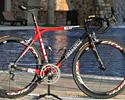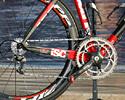
Recently on Cyclingnews.com |
Tech interview: BMC chief engineer Rolf Singenberger, July 6, 2006, part twoThe man behind Floyd's flyerIn the second part of our exclusing interview with Rolf Singenberger, the BMC chief engineer talks about the UCI weight limit, the customisability of carbon frames and BMC's intention to continue pushing bike technology. Part one is here.
CN: The weight limit was set a few years ago. Do you think it should be revised? RS: I think so. I live in Lausanne, very close to Aigle so I go there and have discussions with the UCI about it. Now I think that their minds are starting to change, I realise this. It is kind of difficult for them to set the limit based on weight. From our point of view, they should do safety tests with the material. That means don't give any limitations to the engineers who are trying to make developments. At the moment, we only have to do safety tests for the wheels with the UCI. So they care about wheels, but they don't care about forks or handle bars, the main items you must look at when you talk about safety. It is just a matter of cost, why they don't do all these tests? But actually, we have been invited to show them that a bike of six kilos or below could work, from a safety point of view. I think that now they [the UCI] are more open, but they are still trying to work out how to set the limits, and what they should be.
CN: Can you tell me about the BMC time trial bike? RS: Well, we have been working hard at it. We have a few patents on it - on the fork, on the stem, on the method of construction. We developed the bike one hundred percent in Switzerland. It is expensive but now it is available on the market. There are always the same targets to aim for with a time trial bike. You have the aerodynamic point of view to consider; as you can see, we have an integrated fork and an integrated stem. This is much stiffer and much lighter than a regular system, as well as being much safer. It looks heavy, but last year's equipment was 7.2 kilos. This year we will be at the limit, 6.8 kilos. That is with a full rear desk and a deep section front wheel. And our new design, with more adjustability, is even lighter. CN: The stem is fixed, so you can't change the position… RS: Well, looking at the bike that was used in last year's Tour, each rider had his own mould on the stem, so there was no compromise. No adjustability meant it was lighter, safer, stiffer, while each rider has his own specific position.
That said, in the future, we will give more adjustability. However we won't lose anything in stiffness and, again, we are even lighter with that setup. Going customCN: In old days, the tubes and angles [of steel frames] would have been custom built for riders. But there has been a lot of talk about the difficulty in making custom frames from carbon… RS: Well, is actually easier with carbon, easier to make measurements. With carbon, you have three dimensions. The only thing you have to do with carbon is you must define your shapes, first, the shapes of the mould. After that, then, you just have to put in the layers. Each bike's position is made-to-measure for each rider. In the end, the thing that matters most is this: you have three points where the rider has contact. What matters is their position, relative to the bottom bracket. And this is all made-to-measure. We fit the riders from the little climbers right up to tall guys like Axel Merckx, they are all catered for.
CN: So how will the new time trial frame be different from the previous model? RS: Well as I said, the new bike will have more adjustability. This will mean it is easier to sell [to the public] because the end user will have more adjustability. They will not have to worry if they change the pedal system or if they change the handlebars. Saddles make a lot of difference in height, and also pedals. So we need to take account of that. CN: So if a member of the public goes to buy one of these time trial frames, are they measured up for it? RS: We have a web site (www.personal-precision-programme.com), which gives a complete explanation about the frames, the science behind them, and how to get a custom frame. The customer goes to the web site, put in his measurements - or this measurement can be done by a BMC dealer - and then we send him 3D drawings to confirm. Then we go for it. CN: Now the scary question - what is the price? RS: The frameset is €12,000. Since Vegas, the orders are coming and there is a good level of demand.
CN: What kind of numbers are you putting out each year? RS: Well, BMC do 22,000 bikes. The road segment is maybe half of that, and this particular segment is a few hundred. The time trial bikes sector is limited in the market by its price range. CN: Turning to your own history, how did you originally get into bike engineering? RS: I was competing before, not at pro level but doing some races, and then I was the mechanic for the national team. I studied the geometry point of view, the engineering point of view. Then Andy Riis picked me up from another company to rebuild BMC. That is how I got into working with this company. I think you need to have a passion, that is the whole thing. Business is one thing, but the passion is really important too.
The futureCN: So what is the future direction for the company? RS: Well, we are a Swiss company in Switzerland, we are number one but now we are starting the export business. The US end of things is going quite well, and we have a lot of potential. We are a real engineering-thinking company - first we build up new, innovative ideas, our own way of thinking, and then we go from there. We will only be in the high end and we will only show unique products. We spend quite a bit of time and money on development, that is how it goes. At the high end, we want to be one of the main market frames. CN: It seems that companies like BMC are pushing the development area more than the traditional companies, who perhaps are not coming up with the same range of new ideas…
RS: Well, perhaps for those working in very big companies, it is just a business for them. Maybe they have the right people, but maybe they don't give them the freedom to really go forward and come up with new ideas. Who knows? But you get the feeling sometimes that is about a business rather than new ideas. We have a different take on things, though. Okay, in the end, it has to work from a business point of view, but you also must look at going forward [with the technology]. CN: Do you use wind tunnels or computer models when you're developing the frames? RS: The beginning was done using was a computer model. Our engineering partners are quite involved in aviation. Floyd has done tests in the wind tunnel before and we will be going back again with him. It is never over; new material, new ideas are all important. Those guys give their whole life to win the Tour, so we have to do our part, also. Even if it is just small improvements at a time. PhotographyFor a thumbnail gallery of these images, click here Images by Andy Kessler/BMC
Images by Shane Stokes/Cyclingnews
|







